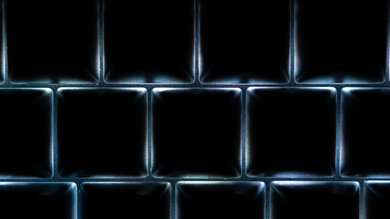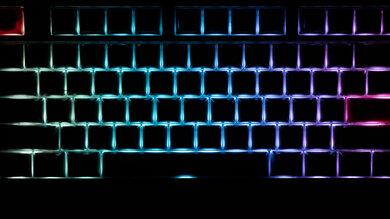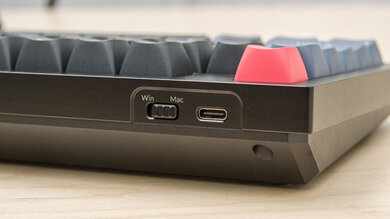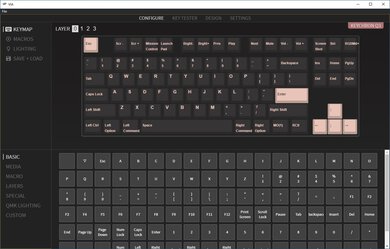The Keychron Q3 is a TenKeyLess customizable keyboard designed for office and productivity use. It's the third installment in the Keychron Q series, a lineup consisting of keyboards with hot-swappable PCBs and a gasket-mounted design for better sound absorption and a softer feel while typing. These Q-series keyboards differ from Keychron's usual offerings since they use a different color scheme and feature spherical keycaps made from PBT plastic. They also lack wireless connectivity options.
Our Verdict
The Keychron Q3 is a great keyboard for gaming use. It feels very well-built and offers a nice typing quality. It comes with your choice of Gateron G Pro clicky Blue, linear Red, or tactile Brown switches, but it also has a hot-swappable PCB, so you can change out these stock switches for any you prefer. Its latency may be too high for competitive gaming, but it's well-suited for casual gaming. While the RGB backlighting adds a nice splash of color, the key legends aren't shine-through, so they're harder to see in the dark. Also, it's a high-profile board that doesn't come with a wrist rest, so you'll have to purchase one separately.
-
Very well-built.
-
Hot-swappable PCB.
-
All keys are macro-programmable.
-
No included wrist rest.
-
Key legends aren't shine-through.
The Keychron Q3 is a wired-only keyboard, so it isn't suitable for use with mobile devices or tablets. However, it does come with a USB-C to USB-C cable, so you can use it with mobile devices that have a USB-C port, but this will drain your device's battery fairly quickly.
The Keychron Q3 is a very good keyboard for office use. It offers a nice typing experience that's very quiet thanks to the gasket-mounted design. Also, it feels incredibly well-constructed and sturdy, so you won't have to worry about it sliding around your desk. Importantly, it's fully compatible with Windows, macOS, and Linux, and you can set the operating system using a toggle on the top of the keyboard. Unfortunately, it doesn't come with a wrist rest, which would improve the comfort overall as it's a high-profile keyboard. Also, you can't connect it wirelessly to other devices, so it's not a good choice if you're looking for a keyboard to use in a multi-device setup.
-
Very well-built.
-
Fully compatible with Windows and macOS.
-
Hot-swappable PCB.
-
Wired-only.
-
No included wrist rest.
The Keychron Q3 is a great keyboard for programming. It feels very well-built, sturdy, and nice to type on, thanks to the premium materials used in its construction. Every key is macro-programmable using the VIA companion software, available on every major operating system. While it has full RGB backlighting, the key legends aren't shine-through, so they'll be hard to read in a dark environment. You can't use this keyboard wirelessly, so it's not a good choice for multi-device setups. Also, it's a high-profile keyboard, but it doesn't come with a wrist rest, which would improve the overall comfort.
-
Very well-built.
-
Fully compatible with Windows and macOS.
-
Hot-swappable PCB.
-
All keys are macro-programmable.
-
Wired-only.
-
No included wrist rest.
-
Key legends aren't shine-through.
The Keychron Q3 is a poor keyboard for use with a home theater PC. You can't connect it wirelessly, so you'll have to run a cable from the keyboard to the PC. It also lacks a trackpad or a built-in navigational tool, so you'll have to use an extra peripheral to go through on-screen menus. While it does have full RGB backlighting, the key legends aren't shine-through, so they're difficult to see in the dark.
-
Very well-built.
-
Hot-swappable PCB.
-
Wired-only.
-
No included wrist rest.
-
Key legends aren't shine-through.
-
No trackpad or wheel for navigating onscreen menus.
- 8.4 Gaming
- 3.4 Mobile/Tablet
- 7.8 Office
- 8.1 Programming
- 5.1 Entertainment / HTPC
Changelog
- Updated Jan 26, 2023: We've added mention of the Keychron S Series keyboards in the Dimensions section of this review.
- Updated Sep 02, 2022: Updated the "White Shot" image to better reflect real-life color mixing observations. This result has changed accordingly. Also updated Linux compatibility as this keyboard is fully compatible with this system. The review now shows these changes.
- Updated May 06, 2022: Review published.
- Updated Apr 29, 2022: Early access published.
- Updated Apr 11, 2022: Our testers have started testing this product.
Check Price
Differences Between Sizes And Variants
The Keychron Q3 has two versions: a pre-built version or a barebones version without switches and keycaps pre-isntalled. The pre-built version is available with either linear Red, clicky Blue, or tactile Brown Gateron G Pro switches. Both versions are available with or without a programmable knob and in three colorways: Carbon Black, Silver Grey, and Navy Blue. We bought and tested the Carbon Black, fully-assembled Keychron Q3 with Gateron G Pro Brown switches. Our unit doesn't have the programmable knob, but we expect our results to remain consistent across variants.
Compared To Other Keyboards
The Keychron Q3 is a wired-only, mechanical keyboard that comes in a TKL form factor. Like other keyboards in the Keychron Q series, it has a gasket-mounted design, and it includes the same operating system switch that you find on any Keychron keyboard. Since it's for office and productivity use, the latency is a bit too high for competitive gaming, and it lacks a lot of basic features found on dedicated gaming keyboards, like a feature to disable the Window's key. Instead, it comes with operating system-specific keycaps for Windows or macOS as it's fully compatible with those two systems and almost fully compatible with Linux.
If you're interested in other options, check out the recommendations for the best typing keyboards and the best mechanical keyboards. If you're interested in what else Keychron has to offer, check out the best Keychron keyboards article.
The Keychron Q1 and the Keychron Q3 are very similar, wired-only, hot-swappable keyboards, but they have a few slight differences. The Q1 comes in a 75% compact form factor, while the Q3 is a TKL size, meaning that the Q3 has more buttons overall, and it also has more space between the alphanumeric keys and the navigational cluster. Also, the Q1 comes with a coiled aviator cable, while the Q3 uses a standard braided cable. On the other hand, the Q3 offers a slightly better typing experience as it has PBT keycaps rather than ABS. Otherwise, the keyboards perform very similarly.
The Keychron K8 and the Keychron Q3 are both TKL-sized mechanical keyboards designed for office use. Both keyboards are hot-swappable, though the K8 requires you to purchase that specific variant. This means you can change out the stock switches for any you want without soldering. However, they have a few differences. The K8 is wireless and pairs with up to three devices simultaneously. On the other hand, the Q3 is wired-only, but it has better latency, and all keys are macro-programmable as it has companion software, which the K8 lacks.
The Keychron Q3 and the Keychron Q5 are both customizable boards in the Q-series. They're nearly identical in performance, with the biggest difference being the size. The Q3 is a TKL (80%) board, so it lacks a numpad, while the Q5 is a full-size (96%) board, so it has the numpad but loses a portion of the navigational cluster.
The Keychron Q2 and the Keychron Q3 are very similar wired-only, hot-swappable keyboards, but they have slight differences. The Q2 is a 65% compact keyboard, so it lacks a row of dedicated function keys, and it's missing some buttons from the navigational cluster. On the other hand, the Q3 is a TKL size, meaning it has a full navigational cluster and a row of dedicated function keys. Both keyboards perform nearly identically, so it's a matter of personal preference on what size you want.
The Keychron Q Series and the Keychron K8 Pro [K2 Pro, K3 Pro, K4 Pro, etc.] are both mechanical keyboard lineups from the manufacturer Keychron. The Keychron Q3 is a TenKeyLess size available in the Q Series. As a whole, the Q Series features a better build quality thanks to their gasket-mounted design. On the other hand, the K Pro Series are wireless keyboards that support multi-device pairing via Bluetooth, and they have a tray-mounted design. Otherwise, both keyboards are very customizable, are compatible with the VIA companion software, and have a hot-swappable PCB.
The GLORIOUS GMMK PRO and the Keychron Q3 are wired-only, mechanical keyboards with hot-swappable PCBs. The GLORIOUS is for gaming use, so it has better latency, a Windows key lock feature, and better RGB backlighting. On the other hand, the Keychron Q3 is for office and productivity use. Its companion software is available on macOS and Linux, so the keyboard is compatible with these systems. It's important to note that the GLORIOUS only comes in a barebones version without pre-installed switches or keycaps, while the Keychron is available fully-assembled and in a barebones variant.
The Ducky One 3 and the Keychron Q3 are both wired-only, mechanical keyboards with hot-swappable PCBs. While the Ducky comes in a variety of sizes, the Keychron only comes in a TKL form factor. These keyboards share several features, including PBT keycaps, solid build qualities, and individually-lit RGB backlighting, but the Ducky has significantly better latency and two incline settings. On the other hand, the Keychron has companion software, so you can program macros and remap keys.
The Keychron Q3 and the Keychron Q4 are both fully customizable keyboards in the Q-series. They have a few minor differences, like the form factor of the Q3 is a TKL size and the Q4 is a compact (60%) board. The Q4 also has a Caps Lock indicator, which the Q3 lacks. Otherwise, they perform nearly identically, so it's a matter of size preference which board you get.
Video
Test Results
The Keychron Q3 is a TenKeyLess (80%) keyboard. It keeps the dedicated arrow and function keys and a portion of the navigational cluster, but it loses a Numpad to open up more space on your desk. Though, if you want a Numpad, check out the Keychron Q5 or the full-size Keychron Q6. Alternatively, if you don't care about either a Numpad or arrow keys, check out the Keychron Q4, which is an even smaller compact keyboard. If you're interested in a similar TenKeyLess keyboard but with a slim, low-profile design, check out the Keychron S Series.
The Keychron Q3 has an incredible build quality. It has a solid aluminum chassis and a metal base plate, so the keyboard has quite a bit of heft and exhibits no flex. The keycaps are smooth, double-shot PBT that feels nice on the fingertips. While there's a bit of wobble in the keys, it's not distracting during use. The four rubber feet do a great job of keeping this board in place, but the weight also helps. This keyboard has a gasket-mounted design, which offers better sound absorption and a softer feel when you bottom the keys out. Inside the board, there's sound-absorbing foam to further dampen the sound. You can purchase this keyboard fully assembled or barebones, meaning it doesn't come with switches or keycaps pre-installed. Regardless of what variant you buy, it's hot-swappable, and you can see a detailed shot of the unit with no keycaps or switches here.
The Keychron Q3 has mediocre ergonomics. It's a high-profile board, so you have to bend your wrists upwards to use it, which can cause some discomfort over long periods. However, you can purchase a wrist rest separately from Keychron, which will improve the overall comfort.
The Keychron Q3 has individually-lit RGB backlighting. Although the companion software doesn't allow you to change the RGB backlighting, you can cycle through lighting effects, brightness settings, and colors using hotkeys. Unfortunately, the key legends aren't shine-through, so you can't see them in the dark.
The Keychron Q3 comes with a USB-C to USB-C braided cable that feels high-quality but retains kinks from the packaging. Also, the above cable length measurement includes the length of the USB-A to USB-C adapter that comes with this keyboard.
The Keychron Q3 is a wired-only keyboard.
The Keychron Q3 has a few extra features. Like other wired Keychron boards, there's a switch in the top left to toggle between Windows and macOS modes. A list of hotkeys that allow you to adjust the lighting effects is included in the user documentation. The media keys are accessible through hotkeys, but these are labeled on the front of the keycap. This keyboard is also hot-swappable, meaning you can swap out the stock switches for any of your choosing without having to solder. You can also purchase a variant of this keyboard with a programmable knob in the top row.
The Keychron Q3 comes with your choice of Gateron G Pro switches in linear Red, clicky Blue, or tactile Brown, but it's also hot-swappable, so you can change out these stock switches for any you prefer without having to solder. The Gateron G Pro Brown switches come pre-lubed, so they feel smooth throughout the keypress. Although the pre-travel distance is on the longer side, this helps to reduce the number of accidental keystrokes. Also, the light operating force keeps the typing feeling light and responsive.
The Keychron Q3 provides an excellent typing experience. The doubleshot PBT keycaps have a smooth surface that feels nice on the fingertips and a unique SA-style shape that's slightly tapered and rounded at the top while the height remains the same as standard (OEM) keycaps. The tactile Gateron G Pro Brown switches provide nice audible and tactile feedback and feel smooth through the duration of the keypress as they're pre-lubed. Although there's a bit of wobble on both the alphanumeric and larger keys, the wobble isn't serious enough to be distracting during use. Despite the compact form factor, the keys feel well-spaced and laid out. Unfortunately, this keyboard has a high profile, so you're more prone to feeling wrist fatigue as you'll have to extend your wrists upwards during use. Fortunately, you can purchase a wrist rest separately through Keychron, improving the overall comfort.
With the Gateron G Pro Brown switches installed, typing on the Keychron Q3 is very quiet. However, if you change the switches for clicky ones, it'll be louder.
The Keychron Q3's latency is decently low, but it's not fast enough for competitive use.
The Keychron Q3 uses the VIA software. You can download the software and all corresponding files directly from the Keychron website. Using the software, you can remap keys and set macros. There are four layers of profiles that correspond to whatever operating system you have toggled during use. Layers 0 and 1 are for Mac systems, while 2 and 3 are for Windows. You can also configure key layouts and save them to your hard drive to access later when you may need them. Additionally, this keyboard is compatible with QMK firmware.
The Keychron Q3 has very good compatibility. It's fully compatible with Windows, macOS, and Linux, meaning all keys work as intended. You'll just have to ensure the toggle is set to the correct operating system, and set to "Mac Mode" to use with Linux systems. The VIA software is available for download on all three major operating systems, so you can remap keys and program macros on any device.
Since this keyboard comes with a USB-C to USB-C cable, you can technically use it with mobile devices that have a USB-C port. On Android phones with this port, all keys work as intended, including the hotkeys. However, as not all mobile devices have a USB-C port, it's considered not compatible.
Comments
Keychron Q3: Main Discussion
Let us know why you want us to review the product here, or encourage others to vote for this product.


































